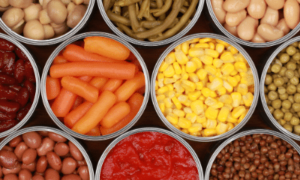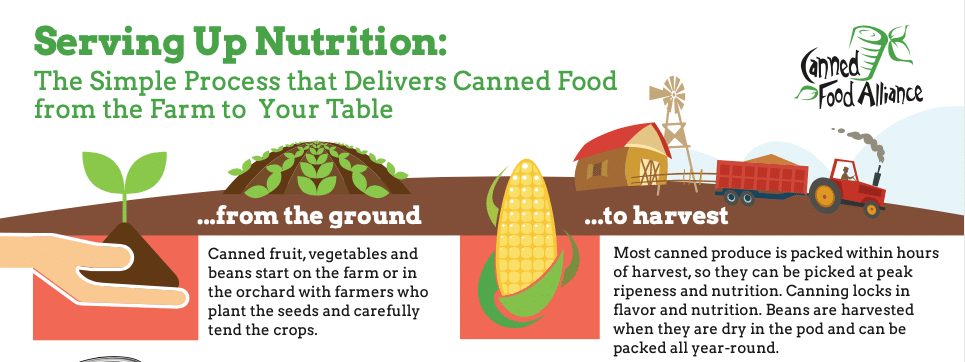
The Tarnished Image
We have the French to thank for the commercial canning process that dates back to the 18th century. History documents that Napoleon Bonaparte offered a cash prize to anyone who could develop a food preservation method that would keep his armies fed. It was Nicholas Appert that developed the initial concept of preserving food in bottles (wine) which led to the processing of food 15 years later. His process then became the launchpad for the Englishman, Peter Durand, to develop the method of sealing food into unbreakable tin containers. By 1813, Bryan Dorkin and John Hall established the first commercial canning factory in England. However, in 1812, the first U.S. canning operation was opened in New York where cans of oysters, meat, fruits and vegetables were processed by Thomas Kensett who had emigrated to the United States. Some 50 years later, Louis Pasteur discovered the science background on why the canning process was effective in eliminating the growth of microorganisms, leading to food spoilage.1 Over the centuries, the canning process of food has been the solution for providing nutritious and safe food to individuals regardless of the season, location or economic status. But has the global distribution and year-round supply of food created an image that “beyond fresh” is not acceptable?

Let me be clear. I love buying fresh fruits and vegetables, especially at farmers’ markets but I learned from growing up on a farm that the bounty of our garden was designed to be consumed not only during the summer and fall months but year-round. Summer day activities included canning and freezing the excess for the winter months. Green beans, tomatoes, tomato juice and pears (from an old tree we had on the farm) were canned, while the corn, broccoli, cauliflower and peas were frozen. Food preservation was just our way of life to ensure we had the freshness and convenience of vegetables in the winter and food waste was eliminated. Hence, it’s concerning when statements are made that gives one the impression that “healthy food” (especially produce) only arrives in a fresh “off the vine” form.
Building on our own kitchen experience, commercial canning today is based on the same principles and methods just on a larger scale. Several years ago, I had the opportunity to experience the canning process in person during a tomato harvest In California. The tomato fields were located near the canning operation so once harvested, trucks filled with tomatoes arrived at the canning operation within minutes. As the tomatoes were unloaded on the conveyor, the washing cycles and processing began immediately. From the time the tomatoes were harvested to the finished canned product, less than four hours had elapsed. A more efficient process, I suspect than the typical home canning project! So why do we have the image that canned fruits and vegetables are inferior? Do we view canned tuna or beans the same way? Let’s look at the facts.
The Real Nutrition Gap
Regardless of the form — canned, frozen or fresh — fruits and vegetables still contain the important vitamins and minerals we all need to improve our immune systems and help fight chronic disease. Over the years numerous studies have been conducted to evaluate the nutritional value of each. A study conducted by the University of California – Davis found that fresh, frozen and canned fruits and vegetables all contained similar levels of nutrients like Vitamin C.2 The results showed that by the time food is consumed, frozen and canned fruits and vegetables may have similar nutritional value (or higher) to fresh options depending on transportation and storage. For example, some canned foods such as tomatoes, pumpkin, corn, carrots, spinach and peaches are actually more nutritious than their fresh and frozen counterparts due to the cooking process. Canned tomatoes actually contain significantly higher quantities of the essential phytochemical lycopene than fresh ones (especially those transported to the Midwest from the California in the middle of winter).
The real nutrition gap for us as consumers is not the form in which we purchase produce, but rather the lack of purchasing and eating enough fruits and vegetables period. As mentioned last month in a review of the 2020-2025 Dietary Guidelines for Americans, our consumption of fruits and vegetables is woefully low and the health status of our population reflects that reality.
Closing the Gap on Waste and Intake
Over the past year, COVID-19 rocked our “norms.” There were times the shelves in the grocery stores were not always full whether due to lack of deliveries or personal “hoarding” due to fear. Regardless of where we land on the “farm to plate” connection, we have thought more about food availability, preparation and waste this past year. Stocking our own pantry shelves as well as those at food banks has become a priority. And in all these situations, the availability of canned foods provides a safe and healthy solution without food waste. Fruits and vegetables have a shelf life of one to two years while canned meat and poultry will keep at their optimal quality for two to five years. High acid foods such as tomatoes and oranges can be stored up to 18 months.
So perhaps we need to press “pause” on the “fresh is best” mindset. When we factor in seasonal availability and quality along with convenience and reduced food waste, it is clear that fresh may not be the “best” on your pantry shelf.
References:
1. “The Canning Process,” Canned Food Alliance
2. “Nutritional comparison of fresh, frozen and canned fruits and vegetables. Part 1. Vitamins C and B and phenolic compounds,” by Joy C. Rickman, Diane M. Barrett and Christine M Bruhn, University of California – Davis, Department of Food Science and Technology.
Other Resources:
“Canned Food Myths – Busted!,” Canned Food Alliance
Download the full infographic from the Canned Food Alliance here

